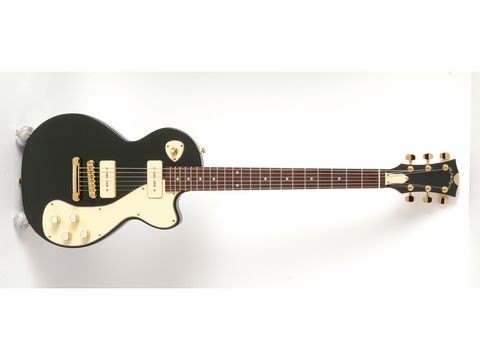In a very loose sense, the Apollo is based on a Les Paul. But it's a bolt-on rather than a set-neck, while the uncontoured slab body is English ash and the neck maple.
It's more like a seventies Gibson Marauder than a mid-fifties Special but, thanks to the generous cream scratchplate that houses the controls and the separate piece used to anchor the three-way toggle switch, one designed in Europe or Japan in the sixties!
But this 'anti-posh' design ethic, aside from being relatively swift to manufacture, is intentional. "The modern, 'streamlined' guitars with skinny necks and 24 frets is a market I don't really understand," says Brian Troup of BJ & Byrne. "We don't really sell that type of guitar in the shop."
"I get the guys that want something with a more classic look," he continues. "The sort of shape and the body thickness of the Apollo came from an old no-name guitar I had with a Hofner neck on this body. It had two P-90s on it and it was probably the nicest guitar I've ever owned and everyone who played it loved it."
The finish
The deep-hued green cellulose finish is admirably glossy but far from mirror-flat, yet there's a functionality to the build that, like Gordon-Smith, isn't high craft but very utilitarian.
The scarf-jointed neck - a bought-in pre-made blank that's shaped and fretted by BJB - rakes back more than a Fender bolt-on thanks to the Gibson-style hardware and is not only nicely shaped, with a full-ish oval C, but tidily fretted and finished on the back with oil and wax, not cellulose.
"I just speak to people in my shop: what do you prefer, heavy lacquer, smooth neck…? Anyone who picks up an old, early sixties Fender neck, it always comes down to the wood, and they always comment on how nice it feels.
"We lacquer the face of the headstock to match the body and we'll lacquer the neck back if you'd prefer it that way, it's really not a problem, but from the off more people seemed to prefer this oil finish."
There's been no skimping on parts: all the hardware is Gotoh and the pickups are from the UK's own Bare Knuckle. "I have no idea how, or why, but I just think the tone is fantastic. To be honest it was Bare Knuckle that gave me the idea to start the company. I'm very patriotic about Britain, not just Scotland, you know?"


